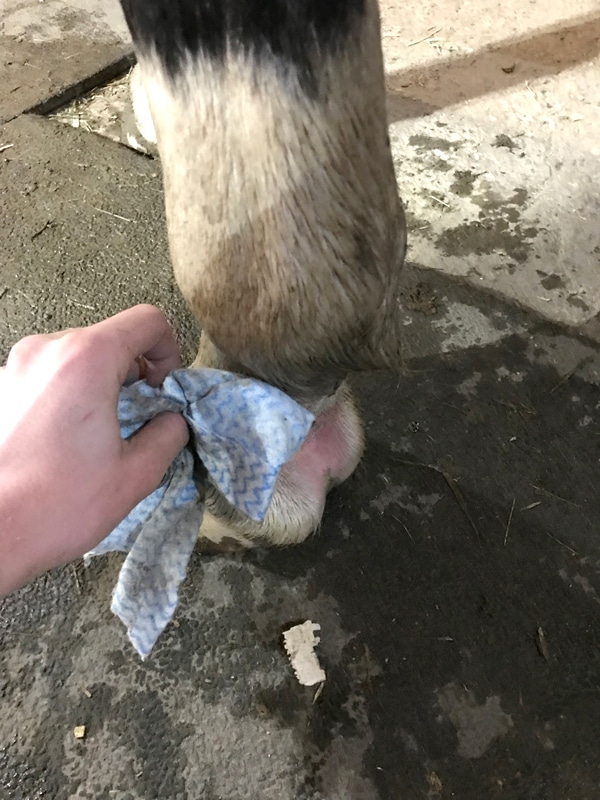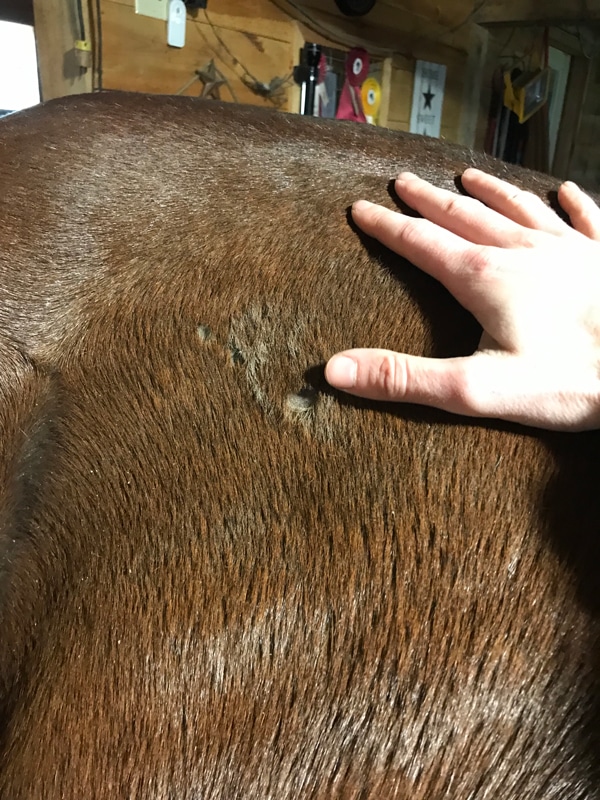During the fall season, there’s often less sunshine, increased moisture, and even persistent bugs, making the perfect breeding ground for skin infections. Although equine skin ailments can sometimes be the symptom of larger problems with the immune system, they are often preventable and treatable with a few consistent, mindful grooming measures that can be incorporated into your regimen and used to identify and treat problems in their early stages.
Mud Fever/Pastern Dermatitis
How to prevent:
Mud fever occurs when the skin becomes compromised by excessive moisture, scratched or punctured, and then infected with bacteria, resulting in inflammation and scabbing. Although it’s often difficult in the fall season, aim to keep your horse’s hooves, heels, and pasterns as dry as possible.

Use a cloth or towel to remove mud on the pasterns rather than a stiff brush, which can scratch the skin and cause problems. (C. Fiset photo)
When grooming the legs, avoid brushing off wet mud, as this can cause small abrasions that can become infected. Mud can be toweled or washed off, or you can wait until the mud is dry and it brushes off more easily. When grooming around the fetlock joint, pasterns, and bulbs of the heels, search for small cuts and proactively disinfect them.
Removing the feathers completely might worsen the problem by causing moisture to collect on the inner pastern and heel. Clippers can also cause irritation that can be worsened by scratching. Minimal trimming of the feathers with scissors will allow you to better inspect and clean the lower legs while also helping the skin to dry more quickly.
How to treat:
The first step is to avoid turning your horse out in a muddy paddock. Next, begin treatment by washing the entire lower leg with disinfectant soap. Rinse thoroughly and allow the leg to dry completely before applying a thick coat of zinc ointment directly over the scabs. Zinc ointment designed specifically for equine mud fever does an excellent job drying the skin. Once the zinc has dried out the scabs for a day or two, they should be much easier to pick off, but sometimes they must be removed incrementally in layers.
In advanced or persistent cases, it may be necessary to use a disinfectant like a half-water, half-betadine solution in a spray bottle localized over the scabs. Continue to clean, dry, and reapply disinfectant and zinc ointment two to three times per week until the scabs can be removed completely. Consistency and patience are key, as it can take many treatments over a period of weeks.
Contact your vet if the mud fever persists or worsens, or if there is excessive heat in the legs and/or lameness occurs.
Rain Rot/Dermatophilosis
How to prevent:
Like mud fever, rain rot is another bacterial infection caused when moisture strips the skin of its resiliency, causing insect bites, scratches, or other irritations to become infected. It appears first as small bumps on the skin and can progress to large regions of matted hair with inflamed, scaly scabs or bald patches underneath.

Rain rot starts as crusty scabs which peel off along with hair, leaving bare patches. (C. Fiset photo)
To prevent, keep your horse’s coat as clean and dry as possible, especially areas that are susceptible to moisture build-up like the shoulders and croup. To avoid causing irritation in these areas, allow your horse’s coat and skin to dry completely before beginning grooming. On rainy days, horses can be sweat-scraped, toweled, and/or dried under a cooler.
Curry in and around the top of the hip joints and along the topline to aerate the skin, encourage blood flow, and create oil production to fight off moisture. Feel beneath the hair with your fingers to identify superficial scrapes and cuts that could be susceptible to infection, de-scabbing and disinfecting when necessary.
How to treat:
To treat rain rot, it’s important to make sure your horse is receiving a chance to dry completely and consistently. If stabling is not an option, ensure your horse has a rain sheet or that he can find shelter under a run-in shed.
If the rain rot is dry, you can gently loosen it with a curry or your hands and brush off the excess hair and dead skin. Afterwards, the area can be washed with antibacterial soap, or if the rain-rot covers a wide area, a disinfectant bath might be in order.
If pus is present, removing the scabs will likely be uncomfortable for your horse, and should be done with care. After removing as much scabbing as easily comes off, bathe your horse with disinfectant soap to remove bacteria from in and around the raw scabs. Then carefully apply an antimicrobial, like the betadine solution, to the raw scabs. Results can usually be seen after a week of consistent care. As with mud fever, be sure to wear gloves, and to disinfect all grooming tools.
Aural Plaques/Ear Papillomas
How to Prevent:
Aural plaques or warts, caused by the papilloma virus, appear as flat, white patches within the ear and, while sometimes sensitive, are mainly a cosmetic issue. They’re typically more prevalent in older horses or horses with immunodeficiencies.
When grooming the ears, a “less is more” approach is better, but it’s also important to prevent the build-up of dirt and bacteria. To clean inside the ears, begin by checking for dirt with your fingers and a flashlight. Remove any dry scabs or other particles, ensuring they don’t fall inside the ear. Avoid using soap to wash the ears. Instead, gently wipe upwards inside the ear, using a thoroughly wrung-out, damp cloth.
How to Treat:
There’s little you can do to treat aural plaques yourself besides keeping the ear clean and dry. Because they’re caused by flies, best way to preventatively treat them is to keep flies out of the ears with a well-fitted fly mask that does not chafe or allow bugs to become trapped within. In times of unpredictable autumn weather, flies can persist long into the fall.
The hair inside the ear is meant to protect the ear and shouldn’t be removed, but if excess hair is poking out of the ear, it can become muddy and flies can use it to their advantage. To clip or scissor-trim these hairs, hold the ear closed from behind, then simply remove the protruding hair. Make sure to brush off any loose hairs with your hands to prevent irritation.
If the aural plaques persist or spread, there are new veterinary-prescribed treatments specifically designed for aural plaques, so talk to your vet.

